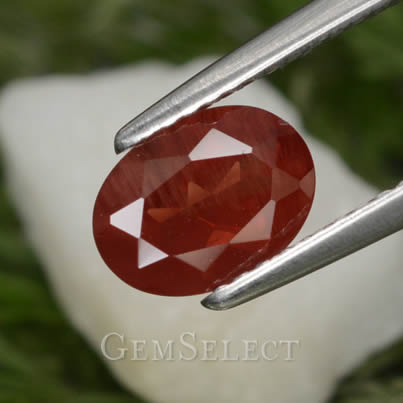The Mystery of Andesine
There is always excitement in the gems world when a new gemstone comes on the market. But sometimes there is mystery as well. That was definitely the case with the recent appearance of a gemstone called andesine.

Red Andesine-Labradorite Gem
There are several mysteries associated with andesine. For one thing, no one seems sure exactly what to call it. Sometimes it is called andesine and sometimes andesine-labradorite. Then there is the question of its origin. No one seems quite sure where it comes from. The original reports said the Congo, then China, Mongolia, Tibet or South India.

Andesine is a member of the group of minerals known as feldspars. In the gemstone world, moonstone is another famous feldspar. But moonstone is an orthoclase feldspar while andesine is one of the plagioclase feldspars, which include oligoclase, andesine, labradorite and bytownite. All the members of the plagioclase group are a mixture of albite and anorthite, with andesine being 50-70% albite (sodium aluminum silicate) and 30-50% anorthite (calcium aluminum silicate). Labradorite is defined as between 50-70% anorthite and 30-50% alibite, so many specimens of similar appearance may fall into one category or the other.

Andesine occurs in a range of colors, from red or honey-red to orange, yellow, champagne or green. It has a hardness of 6 to 6.5 on the Mohs scale, with a dull to vitreous luster. It is translucent to transparent and has perfect cleavage. Due to its hardness, it is not an ideal gem for rings, though it is as hard as tanzanite.

The recently discovered andesine should not be confused with Oregon sunstone, a plagioclase feldspar which is has a shiny metallic "schiller" or glitter caused by light reflections from tiny hematite or goethite or copper platelets.

The name andesine comes from its discovery in the Andes of South America. Its cousin, labradorite, was first discovered in Labrador, Canada. The geographic variation is not surprising, since plagioclase is a major constituent of the Earth's crust. It is possible that andesine occurs in locales as geographically varied as Africa, Tibet and South India.
 Specimens of andesine have been tested for their chemical composition, but only recently has it been determined that many samples, particularly red ones, have been diffusion-treated to improve their color. It is now believed that the red andesine is created by diffusing copper into yellow labradorite. As a precaution, we now label all our andesine labradorite as diffused. But the provenance and treatment of andesine continues to be somewhat of a mystery. Specimens of andesine have been tested for their chemical composition, but only recently has it been determined that many samples, particularly red ones, have been diffusion-treated to improve their color. It is now believed that the red andesine is created by diffusing copper into yellow labradorite. As a precaution, we now label all our andesine labradorite as diffused. But the provenance and treatment of andesine continues to be somewhat of a mystery.
|
